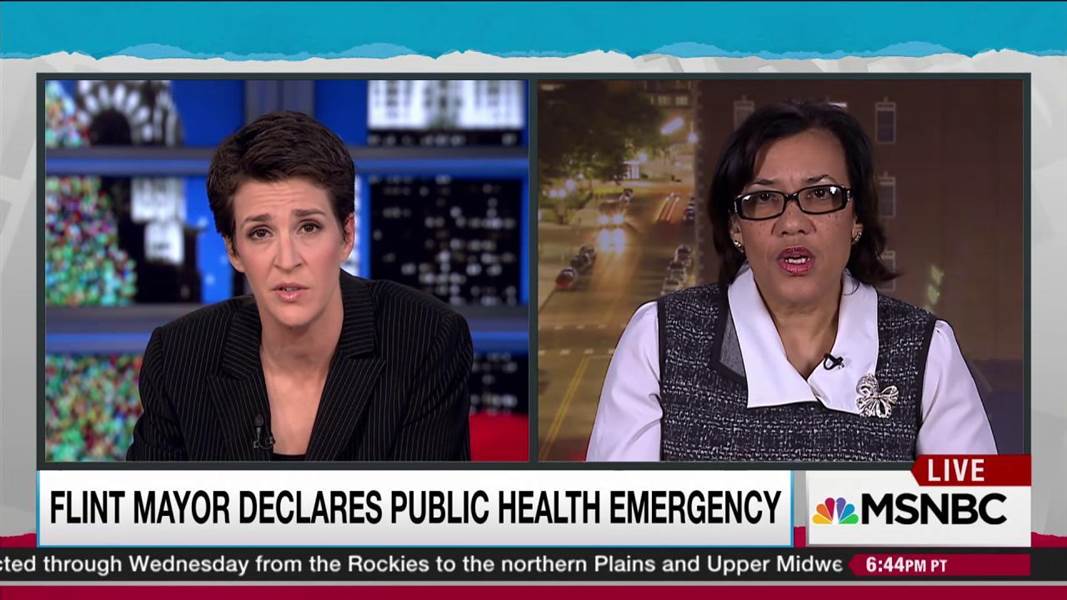|
Thousands of children and adults have been poisoned in Flint, Mich. On Wednesday night in Flint, Rachel Maddow – who has served as a national conscience in this latest tragedy mixing politics and pollution – held a “town-hall” meeting on MSNBC. The meeting provided information and a bit of catharsis for people in Flint -- but no detectable action or shame from the dim-bulb state government that has occupied poor towns in Michigan in recent years. However, Flint is not the only place where poisons have been let loose. More below. This horror in Flint has been coming for years, since Gov. Rick Snyder began appointing unelected “managers” to run some Michigan towns, many of them with large black populations. It looked like the bad old days of South Africa. To save a few bucks, Snyder’s brain trust chose to use water from a polluted river rather than Lake Huron. None of Snyder’s “experts” knew enough to install filters, so lead began showing up in the water – and in children’s bodies. Lately the governor has been standing around, looking a bit stricken, as people passed out donated water bottles, hardly a solution to the health crisis. On Wednesday night we learned that it might cost over $10,000 per house to replace the poisoned lead pipes. No work has started. The state government is now in the position of needing help from a federal government that it has vilified as the enemy -- kind of where we are in this country these days. Maddow has been shining a light on some states with Tea Party and Koch Brother types – North Carolina, Wisconsin, West Virginia, Michigan and Virginia. She reported on Bob McDonnell, then the governor of Virginia, for his fetish for highly personal medical scans of women, labeling him “Governor Ultrasound.” McDonnell and his estranged wife are now appealing prison sentences for corruption while Maddow has moved on to Flint, which badly needed a friend. America is good on polluting itself. The New York Times, in the Jan. 10 issue of its Magazine, ran an absolutely riveting article about how DuPont dumped its refuse in the water table of northern West Virginia for many years. A highly responsible mainstream Cincinnati law firm allowed one of its corporate lawyers to take up – and win -- a pollution case. But with pollution, there are no victories. I recently talked to Mike Glasser, a friend of a friend, who is taking chemo for cancer he believes was incurred while mixing chemicals amounting to Agent Orange. But it was not in Vietnam, where we dumped it willy-nilly. It was at Chanute Air Force Base in eastern Illinois, long closed, with people and animals and lakes and land showing signs of chemical damage. One young reporter, Bob Bajek, took up the issue for a local weekly, and managed to get a highly detailed story published pointing to chemicals used at Chanute more than 40 years ago. Bajek doesn’t work there anymore. One of his superiors said he stirred up trouble, writing things people didn’t like to read. * * * Here are two links by Bob Bajek: His reporting on the pollution: (click link below:) _ and the response to his work: (click link:) _ * * * None of this is new. May I recommend this version of “Black Waters,” performed by Kathy Mattea, from South Charleston, W. Va., as courant as when the great Jean Ritchie of Viper, Ky., wrote it in 1971. Mattea's prelude is worth hearing. Black waters are now flowing in Flint.
Brian Savin
2/5/2016 09:07:16 pm
Today, Friday, Bernie called for Gov Snyder to resign because of what he knew and didn't act upon. Clinton has been an unfocused no show No one should be surprised. Some care about others and some care only about themselves. There is a reall difference in candidates. Comments are closed.
|
Categories
All
|










